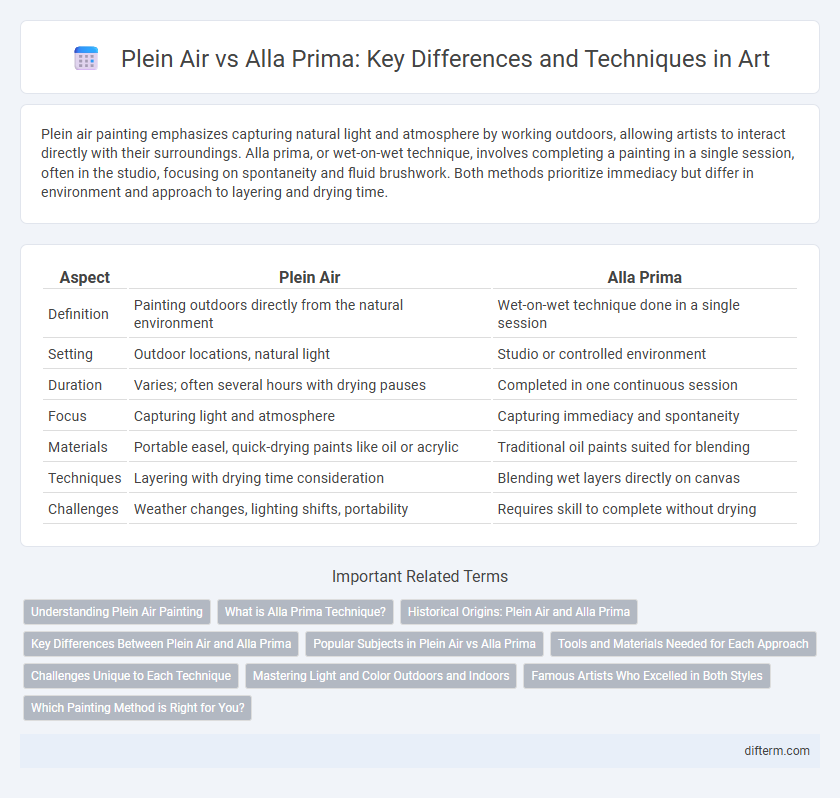Plein air painting emphasizes capturing natural light and atmosphere by working outdoors, allowing artists to interact directly with their surroundings. Alla prima, or wet-on-wet technique, involves completing a painting in a single session, often in the studio, focusing on spontaneity and fluid brushwork. Both methods prioritize immediacy but differ in environment and approach to layering and drying time.
Table of Comparison
| Aspect | Plein Air | Alla Prima |
|---|---|---|
| Definition | Painting outdoors directly from the natural environment | Wet-on-wet technique done in a single session |
| Setting | Outdoor locations, natural light | Studio or controlled environment |
| Duration | Varies; often several hours with drying pauses | Completed in one continuous session |
| Focus | Capturing light and atmosphere | Capturing immediacy and spontaneity |
| Materials | Portable easel, quick-drying paints like oil or acrylic | Traditional oil paints suited for blending |
| Techniques | Layering with drying time consideration | Blending wet layers directly on canvas |
| Challenges | Weather changes, lighting shifts, portability | Requires skill to complete without drying |
Understanding Plein Air Painting
Plein air painting emphasizes capturing natural light and atmosphere by working outdoors, directly observing the environment. This technique often involves multiple sessions to develop layers and details, contrasting with the alla prima approach, which focuses on completing a painting in one sitting with wet-on-wet application. Understanding plein air painting enhances an artist's ability to depict transient effects and the authentic mood of a landscape.
What is Alla Prima Technique?
Alla prima technique is a painting method where artists complete a work in a single session while the paint is still wet, allowing for spontaneous brushstrokes and vibrant color blending. This approach contrasts with plein air, which emphasizes outdoor painting to capture natural light but often involves multiple layers and drying times. Alla prima is favored for its immediacy and dynamic expression, often used in portrait and landscape painting to achieve fresh, lively results.
Historical Origins: Plein Air and Alla Prima
Plein air painting originated in the 19th century, popularized by the Impressionists who sought to capture natural light and atmospheric conditions directly from outdoor landscapes. Alla prima, rooted in the 17th-century Baroque period, emphasizes completing a painting in a single session, allowing spontaneous expression and wet-on-wet techniques. Both methods revolutionized artistic approaches by prioritizing immediacy and authenticity in the creative process.
Key Differences Between Plein Air and Alla Prima
Plein air painting involves creating artwork outdoors, capturing natural light and atmosphere directly from the environment, which often requires quick adjustments to changing conditions. Alla prima, or wet-on-wet painting, is a technique usually executed indoors where the artist completes the piece in one session by applying wet paint layers without waiting for drying, emphasizing immediacy and spontaneity. The key difference lies in plein air's emphasis on external conditions and natural scenery versus alla prima's focus on speed and technique within a controlled setting.
Popular Subjects in Plein Air vs Alla Prima
Popular subjects in plein air painting often include natural landscapes, urban scenes, and direct observations of light and atmosphere, capturing the environment with immediacy and freshness. Alla prima painting typically emphasizes portraits, still lifes, and expressive compositions that benefit from a single, continuous wet-on-wet technique to achieve vibrant color blending and dynamic brushwork. Both methods celebrate spontaneity but differ in subject focus, with plein air rooted in outdoor realism and alla prima favoring controlled studio creativity.
Tools and Materials Needed for Each Approach
Plein air painting typically requires portable easels, lightweight canvases or panels, and a limited palette of fast-drying paints, often oil or acrylic, to accommodate outdoor conditions. Alla prima technique involves using wet-on-wet oil paints applied in a single session, necessitating high-quality brushes, a palette knife, and medium to extend or accelerate drying time. Both methods demand essential tools such as solvent containers, rags, and a sturdy palette, but plein air emphasizes mobility whereas alla prima focuses on paint consistency and blending capabilities.
Challenges Unique to Each Technique
Plein air painting demands artists master swift adaptation to changing natural light and weather, requiring efficient setup and rapid brushwork to capture fleeting outdoor scenes. Alla prima technique challenges painters to complete an artwork in a single session while managing wet-on-wet paint blending for cohesive color transitions and textures. Both methods necessitate precise time management and technical skill, with plein air emphasizing environmental unpredictability and alla prima focusing on controlled spontaneity within a confined timeframe.
Mastering Light and Color Outdoors and Indoors
Mastering light and color outdoors in plein air painting requires adapting to natural, constantly changing daylight and atmospheric conditions, enhancing the artist's ability to capture true color dynamics and shadows. Alla prima technique, often practiced indoors, emphasizes swift, direct application of paint while wet, demanding a keen understanding of color mixing and light source manipulation within a controlled environment. Both methods develop distinct skills in observing and rendering light effects, with plein air fostering spontaneity and alla prima refining precision in tonal gradation.
Famous Artists Who Excelled in Both Styles
Claude Monet mastered plein air painting, capturing natural light and landscapes with vivid immediacy, while also excelling in alla prima techniques that allowed him to complete works in a single session. John Singer Sargent combined his plein air studies of outdoor scenes with alla prima brushwork, producing dynamic portraits and landscapes that exhibit spontaneity and precision. Winslow Homer's skill in both plein air and alla prima is evident in his marine and outdoor scenes, where rapid brushstrokes and direct observation emphasize realism and atmosphere.
Which Painting Method is Right for You?
Plein air painting emphasizes capturing natural light and atmosphere by working outdoors, providing vivid, immediate impressions of the landscape. Alla prima, or wet-on-wet, is a faster technique often completed in one sitting, ideal for artists seeking spontaneity and bold brushwork. Choosing between these methods depends on your preference for working environment, speed, and the desired level of detail in your artwork.
plein air vs alla prima Infographic

 difterm.com
difterm.com